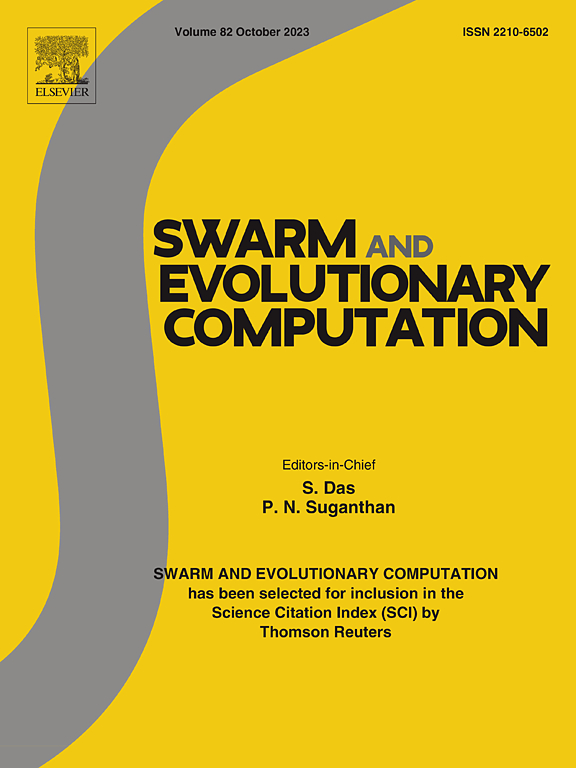An augmented variable neighborhood search for mixed-model two-sided assembly line balancing considering PM scenarios
IF 8.5
1区 计算机科学
Q1 COMPUTER SCIENCE, ARTIFICIAL INTELLIGENCE
引用次数: 0
Abstract
In a real mixed-model two-sided assembly line, preventive maintenance (PM) activities cause capacity waste at available stations and production halts. To mitigate these issues, multiple task assignment schemes with high interchangeability are required, each tailored to one specific scenario. However, the resulting mixed-model two-sided assembly line balancing problem considering PM scenarios (MTALBP-PM) has not been studied. Therefore, a mixed-integer linear programming model is formulated to minimize total cycle time and task adjustment simultaneously. Meanwhile, driven by knowledge and learning, an augmented variable neighborhood search (AVNS) is designed. Concretely, with the guidance of problem-specific knowledge, a decoding mechanism and three objective-oriented neighborhood structures are designed to achieve solutions with better objectives. Using unsupervised learning, an initialization heuristic is mined from tacit information to obtain high-quality initial solutions. With historical search information, a self-adaptive strategy based on Q-learning is proposed to recommend the best-fit neighborhood structure for higher efficiency. Besides, an auto-tuning restart operator based on multi-domain knowledge is employed to escape local optima. Experimental results show that the espoused policy is effective, and AVNS outperforms eight other state-of-the-art meta-heuristics in deriving well-converged and -distributed Pareto fronts. In a statistical sense, the average GD, IGD, and HVR of AVNS reach the best values among all tested meta-heuristics based on 40 benchmark cases, which are 0.4599, 0.8021, and 0.8943, respectively.
考虑PM场景的混合模型双面装配线平衡增广变量邻域搜索
在实际的混合型双面装配线中,预防性维护(PM)活动会导致可用工位的产能浪费和生产中断。为了缓解这些问题,需要具有高互换性的多个任务分配方案,每个方案都针对一个特定的场景进行定制。然而,由此产生的考虑PM情景的混合模型双边装配线平衡问题(MTALBP-PM)尚未得到研究。因此,建立了一个混合整数线性规划模型,使总周期时间和任务调整同时最小化。同时,在知识和学习的驱动下,设计了一种增广变量邻域搜索算法。具体而言,在问题特定知识的指导下,设计一种解码机制和三个面向目标的邻域结构,以获得具有更好目标的解决方案。利用无监督学习,从隐性信息中挖掘初始化启发式,获得高质量的初始解。在历史搜索信息的基础上,提出了一种基于q学习的自适应策略来推荐最适合的邻域结构,从而提高搜索效率。此外,采用基于多领域知识的自调优重启算子逃避局部最优。实验结果表明,所采用的策略是有效的,AVNS在推导良好收敛和分布的帕累托前沿方面优于其他八种最先进的元启发式方法。在统计意义上,基于40个基准案例,AVNS的平均GD、IGD和HVR在所有测试的元启发式中达到最佳值,分别为0.4599、0.8021和0.8943。
本文章由计算机程序翻译,如有差异,请以英文原文为准。
求助全文
约1分钟内获得全文
求助全文
来源期刊

Swarm and Evolutionary Computation
COMPUTER SCIENCE, ARTIFICIAL INTELLIGENCEC-COMPUTER SCIENCE, THEORY & METHODS
CiteScore
16.00
自引率
12.00%
发文量
169
期刊介绍:
Swarm and Evolutionary Computation is a pioneering peer-reviewed journal focused on the latest research and advancements in nature-inspired intelligent computation using swarm and evolutionary algorithms. It covers theoretical, experimental, and practical aspects of these paradigms and their hybrids, promoting interdisciplinary research. The journal prioritizes the publication of high-quality, original articles that push the boundaries of evolutionary computation and swarm intelligence. Additionally, it welcomes survey papers on current topics and novel applications. Topics of interest include but are not limited to: Genetic Algorithms, and Genetic Programming, Evolution Strategies, and Evolutionary Programming, Differential Evolution, Artificial Immune Systems, Particle Swarms, Ant Colony, Bacterial Foraging, Artificial Bees, Fireflies Algorithm, Harmony Search, Artificial Life, Digital Organisms, Estimation of Distribution Algorithms, Stochastic Diffusion Search, Quantum Computing, Nano Computing, Membrane Computing, Human-centric Computing, Hybridization of Algorithms, Memetic Computing, Autonomic Computing, Self-organizing systems, Combinatorial, Discrete, Binary, Constrained, Multi-objective, Multi-modal, Dynamic, and Large-scale Optimization.
 求助内容:
求助内容: 应助结果提醒方式:
应助结果提醒方式:


